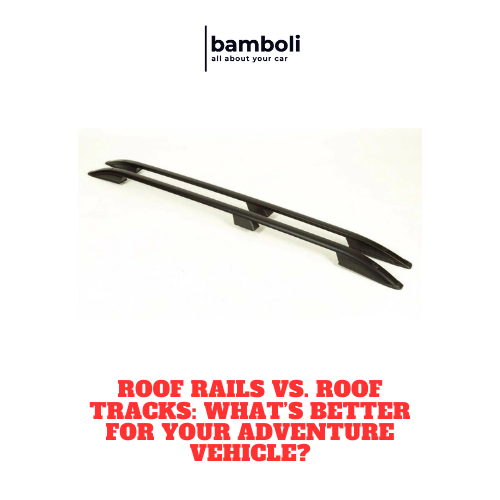Roof Rails vs. Roof Tracks: What’s Better for Your Adventure Vehicle?

Roof Rails vs. Roof Tracks: What’s Better for Your Adventure Vehicle?
Are you debating between roof rails and roof tracks for your adventure vehicle? Choosing the right option can make a significant difference in your overall driving experience. Both roof rails and roof tracks have their advantages and drawbacks, so it's essential to weigh your options carefully. In this article, we will explore the differences between roof rails and roof tracks to help you make an informed decision for your next adventure. Let's dive in and see which one might be better suited for your needs!
Comparing the Pros and Cons of Roof Rails for Adventure Vehicles
Roof rails are a popular accessory for adventure vehicles, offering a range of benefits for outdoor enthusiasts. However, they also come with certain drawbacks to consider before making a purchase. Let's take a closer look at the pros and cons of roof rails:
Pros:
- Versatility: Roof rails provide a secure and stable platform for transporting a variety of gear, such as bikes, kayaks, and luggage.
- Increased Storage: By utilizing roof rails, you can free up space inside your vehicle for passengers and other essentials.
- Enhanced Aesthetics: Roof rails can give your vehicle a sleek and rugged look, perfect for outdoor adventures.
Cons:
- Wind Resistance: Roof rails can increase wind resistance, leading to decreased fuel efficiency at higher speeds.
- Height Restrictions: With gear loaded on the roof, your vehicle may no longer fit in low-clearance areas like parking garages or drive-throughs.
- Cost: The purchase and installation of roof rails can be a significant investment, especially for high-quality models.
Before deciding whether roof rails are right for your adventure vehicle, weigh these pros and cons carefully to ensure you make an informed choice that suits your needs and budget.
Exploring the Benefits of Roof Tracks in Off-Road Environments
Roof tracks are a versatile and valuable addition to any off-road vehicle. These specially designed tracks are mounted on the roof of the vehicle, providing additional traction and stability in challenging terrain. While roof tracks may not be necessary for every off-road adventure, they offer a range of benefits that make them worth considering.
Enhanced Traction
One of the primary benefits of roof tracks is the enhanced traction they provide. In muddy, sandy, or rocky terrain, traditional tires can struggle to maintain grip. Roof tracks distribute the weight of the vehicle more evenly, reducing the risk of getting stuck or sliding. This increased traction allows off-road enthusiasts to confidently tackle steep inclines, deep mud, and other challenging obstacles.
Improved Stability
Roof tracks also contribute to improved stability on uneven terrain. The wider footprint of the tracks helps to prevent tipping and rollovers, keeping the vehicle steady and secure. This added stability can make off-road driving safer and more enjoyable, particularly in extreme conditions.
Expanded Off-Road Capabilities
|
Terrain Type |
Benefits |
|
Mud |
Prevents getting stuck |
|
Sand |
Enhanced traction |
|
Rock |
Improved stability |
Roof tracks can expand the off-road capabilities of a vehicle, allowing drivers to tackle a wider range of terrain with confidence. Whether navigating through deep mud, crossing sandy dunes, or climbing rocky trails, roof tracks offer a competitive edge in off-road environments.
In conclusion, the benefits of roof tracks in off-road environments are undeniable. From enhanced traction and improved stability to expanded off-road capabilities, these innovative accessories can make a significant difference in the performance and safety of off-road vehicles. Whether for recreational adventures or professional expeditions, roof tracks are a valuable investment for any off-road enthusiast.
Choosing the Right Roof Mounting System: Rails or Tracks?
When it comes to installing solar panels on your roof, one of the most important decisions you'll need to make is choosing the right mounting system. Two common options you'll likely come across are rail-based systems and track-based systems. Both have their own set of advantages and disadvantages, so it's crucial to understand the differences between the two before making a decision.
The Benefits of Rail-Based Systems
Rail-based mounting systems consist of aluminum rails that are attached to the roof, allowing the solar panels to be mounted on top. One of the main advantages of rail-based systems is their versatility. They can easily accommodate different types and sizes of solar panels, making them a popular choice for residential and commercial projects alike. Additionally, rail-based systems are often more cost-effective and easier to install compared to track-based systems.
The Advantages of Track-Based Systems
Track-based mounting systems, on the other hand, use tracks that are attached directly to the roof, eliminating the need for rails. One of the major benefits of track-based systems is their ability to adjust to the changing position of the sun throughout the day. This allows for optimal solar panel efficiency and energy production. Track-based systems are also less prone to shading issues, making them ideal for rooftops with limited space or obstructions.
Ultimately, the decision between rail-based and track-based mounting systems will depend on your specific needs and preferences. When considering durability, efficiency, and cost, it's important to weigh the pros and cons of each option carefully. Whichever system you choose, make sure to consult with a professional solar installer to ensure a successful and long-lasting installation.
Enhancing Your Adventure Vehicle: Roof Rails vs Roof Tracks
Enhancing your adventure vehicle for your outdoor excursions, one important decision you'll have to make is whether to install roof rails or roof tracks. Both options have their own benefits and drawbacks, so it's important to understand the differences between the two before making a choice.
Roof Rails:
Convenience: Roof rails are typically easier to install and remove, making them a convenient option for those who want a temporary solution.
Weight Capacity: Roof rails usually have a lower weight capacity compared to roof tracks, so they may not be suitable for heavy loads.
Aerodynamics: Roof rails can create more drag and wind noise compared to roof tracks, affecting your vehicle's fuel efficiency.
Roof Tracks:
Weight Capacity: Roof tracks have a higher weight capacity than roof rails, making them ideal for carrying heavy gear such as kayaks, bikes, or roof tents.
Compatibility: Roof tracks are compatible with a wider range of roof accessories, giving you more flexibility in customizing your adventure vehicle.
Durability: Roof tracks are generally more durable and resilient, making them a long-term investment for your vehicle.
In conclusion, the decision between roof rails and roof tracks ultimately depends on your specific needs and preferences. If you prioritize convenience and ease of installation, roof rails may be the better option for you. However, if you require a higher weight capacity and durability, roof tracks are the way to go. Consider your adventure vehicle's requirements and choose accordingly to enhance your outdoor experiences.
Maximizing Utility: The Case for Roof Tracks Over Roof Rails
Choosing the best option for your vehicle's roof, the debate between roof tracks and roof rails is one that often arises. Both options have their own benefits and drawbacks, but when it comes to maximizing utility, roof tracks come out on top.
The Benefits of Roof Tracks
Rooftop tracks offer a more versatile and customizable option for carrying cargo on your vehicle. With roof tracks, you have the ability to easily adjust and move crossbars to accommodate different size loads. This flexibility allows you to maximize the space on your roof and efficiently transport a variety of items.
Another key benefit of roof tracks is their low profile design, which reduces wind resistance and noise while driving. This not only improves aerodynamics, but also contributes to better fuel efficiency. Additionally, roof tracks are generally more durable and long-lasting compared to roof rails, providing a reliable solution for all your cargo needs.
Why Roof Rails Fall Short
While roof rails may provide a more streamlined look for your vehicle, they lack the versatility and adjustability that roof tracks offer. With roof rails, you are limited to a fixed position for your crossbars, which can restrict the types of cargo you can transport and how much you can carry.
Furthermore, roof rails are often less secure than roof tracks, as they rely on clamps or brackets to attach to your vehicle. This can lead to potential shifting or movement of your cargo during transit, posing a safety risk for both you and other drivers on the road.
In conclusion, when it comes to maximizing utility and efficiency, roof tracks are the superior choice over roof rails. Their customizable design, durability, and security make them the ideal option for all your rooftop cargo needs.
A Comprehensive Guide to Roof Rails and Tracks for Your Adventure Vehicle
Roof rails and tracks are essential components for any adventure vehicle, providing the foundation for carrying gear such as bikes, kayaks, or cargo boxes. Understanding the different types and features of roof rails and tracks can help you make the best choice for your specific needs.
Types of Roof Rails and Tracks
There are two main types of roof rails: raised side rails and flush side rails. Raised side rails are more common and provide a raised platform along the sides of the vehicle for mounting accessories. Flush side rails are integrated into the roofline of the vehicle and offer a sleeker look.
Roof tracks, on the other hand, are a more versatile option for mounting accessories. They consist of a track system that runs along the length of the roof, allowing you to adjust the position of your gear to accommodate different sizes and shapes.
Features to Consider
When choosing roof rails and tracks for your adventure vehicle, consider the following features:
|
Feature |
Description |
|
Load Capacity |
Make sure the roof rails and tracks can support the weight of your gear. |
|
Compatibility |
Check if the roof rails and tracks are compatible with your vehicle's make and model. |
|
Installation |
Consider how easy or difficult it is to install the roof rails and tracks. |
Choosing the right roof rails and tracks can make a significant difference in the functionality and versatility of your adventure vehicle.
Frequently Asked Questions
What is the topic of the blog article?
The topic of the blog article is about...
Who is the target audience for this article?
The target audience for this article is...
How can readers benefit from reading this article?
Readers can benefit from this article by...
Are there any related resources or links mentioned in the article?
Yes, the article includes related resources and links such as...
Is there a call-to-action at the end of the article?
Yes, the article includes a call-to-action encouraging readers to...




